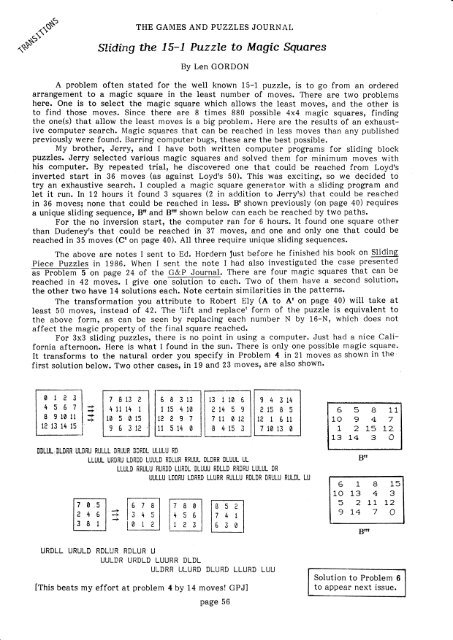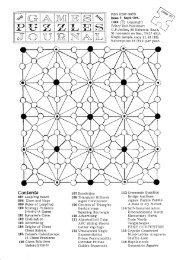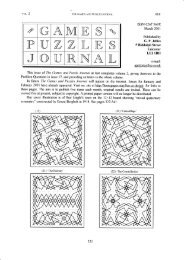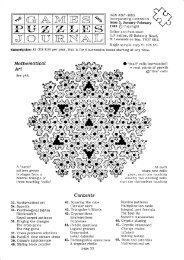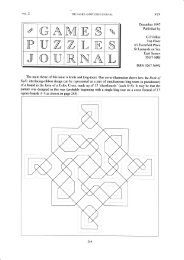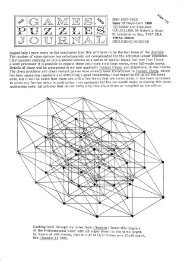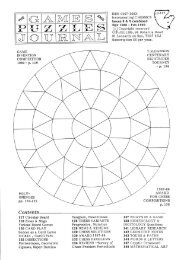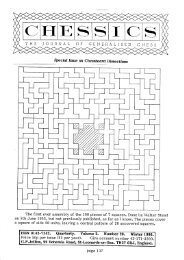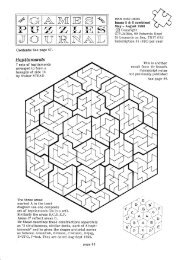The Games and Puzzles Journal, #4 - Mayhematics
The Games and Puzzles Journal, #4 - Mayhematics
The Games and Puzzles Journal, #4 - Mayhematics
You also want an ePaper? Increase the reach of your titles
YUMPU automatically turns print PDFs into web optimized ePapers that Google loves.
'c-r> ^^{s<br />
($N"<br />
THE GAMES AND PUZZLES JOURNAI,<br />
Slfdfng tFce 75-7 Puzzle to Mogic Sflrares<br />
By Len GORDON<br />
A problem often stated for the well known 15-1 puzzle, is to go from an ordered<br />
arrangement to a magic square in the least number of moves. <strong>The</strong>re are two problems<br />
here. One is to select the magic square which allows the least moves, <strong>and</strong> the other is<br />
to find those moves. Since there are 8 times 880 possible 4x4 magic squares, finding<br />
the one(s) that allow the least moves is a big problem. Here are the results of an exhaustive<br />
computer search. Magic squares that can be reached in less moves than any published<br />
previously were found. Barring computer bugs, these are the best possible.<br />
My brother, Jerry, <strong>and</strong> I have both written computer programs for sliding block<br />
puzzles. Jerry selected various magic squares <strong>and</strong> solved them for minimum moves with<br />
his computer. By repeated trial, he discovered one that could be reached from Loyd's<br />
inverted start in 36 moves (as against Loyd's 50). This was exeiting, so we decided to<br />
try an exhaustive search. I coupled a magic square generator with a sliding program <strong>and</strong><br />
let it run. In 12 hours it found 3 squares (2 in addition to Jerry's) that could be reached<br />
in 36 moves; none that could be reached in less. Br shown previously (on page 40) requires<br />
a unique sliding sequence, Brr <strong>and</strong> Btrr shown below can each be reached by two paths.<br />
For the no inversion start, the computer ran for 6 hours. It found one square other<br />
than Dudeney's that could be reached in 3 moves, <strong>and</strong> one <strong>and</strong> only one that could be<br />
reached in 35 moves (C'on page 40). All three require unique sliding sequences.<br />
<strong>The</strong> above are notes I sent to Ed. Hordern Just before he finished his book on Sliding<br />
Piece <strong>Puzzles</strong> in 1986. When I sent the note I had also investigated the case presented<br />
affionpage24oftheG&P<strong>Journal</strong>.<strong>The</strong>rearefourmagicSguaresthatcan.be<br />
reached in 42 moves. I give oneJ6iltion-E-each."Two of them have a second solution'<br />
the other two have 14 solutions each. Note certain similarities in the patterns.<br />
<strong>The</strong> transformation you attribute to Robert Ely (A to Ar on page 40) wilt take at<br />
least 50 moves, instead of 42. <strong>The</strong> 'lift <strong>and</strong> replace' form of the puzzle is equivalent to<br />
the above form, as can be seen by replacing each number N by 16-N, which does not<br />
affect the magic property of the final square reached.<br />
For 3x3 sliding puzzles, there is no point in using a computer. Just had a nice California<br />
afternoon. Here is what I found in the sun. <strong>The</strong>re is only one possible magic square.<br />
It transforms to the natural order you specify in Problem 4 in 21 moves as shown in the'<br />
first solution below. Two other cases, in 19 <strong>and</strong> 23 moves, are also shown'<br />
0<br />
4<br />
I<br />
te<br />
1e3<br />
567<br />
I 10 11<br />
13 14 15<br />
-+ -+<br />
r+ -><br />
B<br />
It<br />
e<br />
I<br />
5 15<br />
5 B 3 13<br />
I 15 4 10<br />
re I7<br />
lt 5 14 0<br />
t3 1 10<br />
t4 5<br />
7 11 0<br />
I 4 t5<br />
6<br />
I<br />
1t<br />
3<br />
6 5 B t1<br />
10 9 4 7<br />
1 2 L5 12,<br />
L3 L4 3 0<br />
DDLUL;DLDRR IJLDRU RULLL DRUUR DCRDL ULULU RD<br />
LLUUL URDRU LDRDD LUULD RDLUR RRUUL DLDRR DLUUL UL<br />
LLULD RRULU RURDD LURDL DLUW RDLLD RRDRU LULIJL DR<br />
UULLU LDDRU LDRRD LLURR RULLU RDLDR DRULU RULDL LU<br />
Brr<br />
6 1 B 15<br />
10 13 4 3<br />
5 2 11 L2<br />
9L4 7 O<br />
Brrr<br />
URDLL URULD RDLUR RDLUR U<br />
UULL1R URDLD LUURR DLDL<br />
ULDRR ULURD DLURD LLURD<br />
[fnis beats my effort at problem 4 by L4 moves! GPJ]<br />
page 56<br />
LUU<br />
Solution to Problem 6<br />
to appear next issue.


